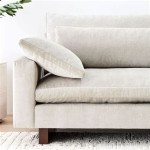Leather Sofa Getting Sticky After Cleaning: Understanding the Phenomenon and Finding Solutions
A leather sofa is a significant investment and a centerpiece of many living rooms. Proper care and regular cleaning are essential to maintain its appearance and longevity. However, a common problem arises after cleaning: the leather becomes sticky. This unexpected stickiness can be frustrating and concerning, prompting questions about what went wrong and how to rectify the situation. This article explores the reasons behind this phenomenon and provides practical solutions for restoring the leather's original texture.
The stickiness that develops after cleaning a leather sofa is not usually an inherent property of the leather itself. Rather, it is a consequence of residue left behind by the cleaning product or a reaction of the product with the leather's surface. Understanding the underlying causes is crucial for choosing the appropriate cleaning methods and avoiding future occurrences.
Improper Cleaning Product Selection and Application
One of the most common culprits behind sticky leather is the use of inappropriate cleaning products. Leather is a delicate material, and harsh chemicals or abrasive cleaners can strip away its natural oils and protective coatings. This can leave the leather feeling dry, cracked, and, paradoxically, sticky. Many commercially available cleaning products contain ingredients that are too strong for leather, such as solvents, alcohol, or ammonia. These substances can dissolve the leather's finish and leave behind a sticky residue.
Furthermore, even if a product is specifically labeled as "leather cleaner," it is vital to read the instructions carefully and test it on an inconspicuous area before applying it to the entire sofa. Over-application of any cleaning product can also contribute to stickiness. Excess cleaner seeps into the leather's pores and, if not properly removed, will leave a tacky residue as it dries. The instructions on cleaning products will often specify the amount of cleaner that should be applied to a cleaning cloth, and it is important to follow those guidelines. Applying too much product directly to the leather can cause saturation, which will make residue removal more difficult.
The appropriate type of leather also matters. Aniline, semi-aniline, and protected (or pigmented) leather each require different cleaning approaches. Aniline leather, being the most natural and porous, is the most susceptible to damage from improper cleaning. Protected leather, on the other hand, has a protective coating that makes it more resistant to stains and damage, but even this type of leather can be affected by harsh chemicals.
Even seemingly harmless household cleaners, such as dish soap or vinegar, can be detrimental to leather. While they may seem effective for removing dirt and grime, these substances can disrupt the leather's pH balance and cause it to dry out and become sticky. It is always best to use cleaning products specifically formulated for leather or to consult a professional leather cleaner for advice.
Residue Buildup from Previous Cleaning Attempts
Repeated cleaning with inappropriate products can lead to a buildup of residue on the leather's surface. Each cleaning attempt may leave a thin layer of residue behind, which accumulates over time and creates a sticky film. This film attracts dirt and grime, further exacerbating the problem. This is especially true if the leather is not properly conditioned after each cleaning. Leather conditioners help to replenish the natural oils that are lost during cleaning, preventing the leather from drying out and becoming sticky.
The type of residue that accumulates can vary depending on the cleaning products used. Some cleaners leave behind a waxy residue, while others leave behind a soapy or oily residue. Regardless of the type of residue, it is essential to remove it completely to restore the leather's original texture. This may require multiple cleaning attempts using a gentle leather cleaner and a soft cloth.
A related issue is the use of hard water for cleaning leather. Hard water contains minerals that can react with cleaning products and leave behind a chalky or sticky residue. Using distilled water for cleaning leather can help to prevent this problem. Distilled water is free of minerals and impurities, making it a safer and more effective cleaning agent.
Regular cleaning is important, but it should be approached with caution. Over-cleaning can be just as damaging as not cleaning at all. A light dusting or vacuuming of the leather sofa every week is usually sufficient to remove surface dirt and prevent buildup. More thorough cleaning should only be done as needed, typically every few months.
Environmental Factors Contributing to Stickiness
Environmental factors can also play a role in the development of sticky leather. High humidity, for example, can cause cleaning products to dry slower and leave behind a more noticeable residue. In humid environments, it is important to ensure adequate ventilation during and after cleaning to allow the leather to dry properly.
Exposure to direct sunlight can also damage leather and make it more prone to stickiness. Sunlight can fade the leather's color and dry out its natural oils. This can leave the leather feeling brittle and sticky. It is best to keep leather furniture out of direct sunlight or to use window coverings to protect it from the sun's harmful rays.
Another environmental factor is exposure to heat. Placing a leather sofa near a radiator or fireplace can cause the leather to dry out and become sticky. Heat can also cause the leather's finish to crack and peel, further exacerbating the problem. It is important to keep leather furniture away from sources of heat to prevent damage.
Air pollution can also contribute to the buildup of dirt and grime on leather furniture. Regular cleaning is necessary to remove these pollutants and prevent them from damaging the leather. Using an air purifier can help to reduce the amount of air pollution in the home and protect leather furniture.
In addition to these factors, the age of the leather can also affect its susceptibility to stickiness. Older leather tends to be drier and more porous than newer leather, making it more prone to absorbing cleaning products and developing a sticky residue. Older leather may require more frequent conditioning to maintain its moisture levels and prevent it from drying out.
Addressing the issue of sticky leather requires a systematic approach. First, identify the potential cause. Was an inappropriate cleaning product used? Is there evidence of residue buildup from previous cleaning attempts? Are environmental factors contributing to the problem? Once the cause is identified, the appropriate solution can be implemented. This often involves carefully removing any existing residue and restoring the leather's natural oils. Subsequent cleaning practices should also be adjusted to prevent future occurrences of stickiness.

Sticky Leather Or Vinyl What Causes It How To Clean

4 Reasons Leather Becomes Sticky Plus Easy Fix

How To Clean Leather Furniture When It Gets Sticky Arrow
I Cleaned A Stain On Leather Couch With An Wipe It Changed The Color And Looks Worse Now How Can Re Original Quora

Sticky Residue On Leather Learn How To Remove It With Ease Leatherneo

7 Tips And Tricks To Clean Leather Sofa End Of Tenancy Cleaning Me Blog

Homemade Leather Sofa Cleaner Our Oily House

Easy Way To Clean Leather Furniture Home Cleaning

I Ytimg Com Vi Doa0gzfpqcw Hq720 Jpg Sqp Oaymwehc
How To Get An Oil Stain Off A Leather Couch Quora








